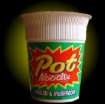 The big 3 in the worldwide noodle conspiracy.
The big 3 in the worldwide noodle conspiracy.Noodles are a nutritional, healthy and most importantly popular source of nutrition, but I am afraid to say that for the most part they are poison.
Noodles and pasta have traditionally been poison free, and pasta still is as long as it is NOT made from genetically modified flour. (any and all GM products are poison!!)
For some obscure reason known only to 'Them', 'They' have gone for the poisoning of noodles in a big way.
There is only one noodle that is totally poison free, but we will discuss this later on;
Firstly you must be warned about the two most toxic noodles on the market, these two products contain almost as much poison as Krispy Kreme's glazed creme filled, glazed Lemon filled, and glazed Raspberry filled donuts ( the most toxic of the notorious Krispy Kreme range).
 Potnoodle consists of dehydrated noodles and powdered emulsifiers and artificial* flavors shoveled into the bottom of a plastic cup. A small sachet of some vile tasting liquid condiment is placed on top of the dried contents and then is vacuum sealed with a foil lid. You then have the pleasure of listening to it rattle at the bottom of the shopping bag while you walk home, where on arrival you will place it at the back of the kitchen cabinet with 'no real' intention of eating it. Until that fateful night when you come back miraculously drunk for an evening out, or very very stoned,can't stomach cornflakes, switch the kettle on and take that deadly rattling plastic container from the cabinet. (STOP!!!! THIS WILL POISON YOU!!!!)
Potnoodle consists of dehydrated noodles and powdered emulsifiers and artificial* flavors shoveled into the bottom of a plastic cup. A small sachet of some vile tasting liquid condiment is placed on top of the dried contents and then is vacuum sealed with a foil lid. You then have the pleasure of listening to it rattle at the bottom of the shopping bag while you walk home, where on arrival you will place it at the back of the kitchen cabinet with 'no real' intention of eating it. Until that fateful night when you come back miraculously drunk for an evening out, or very very stoned,can't stomach cornflakes, switch the kettle on and take that deadly rattling plastic container from the cabinet. (STOP!!!! THIS WILL POISON YOU!!!!)*Potnoodle claim to contain no artificial flavors or preservatives:
The ingredients are- Noodles (49%) [wheat flour, vegtable oil, salt], water, vegtable in variable proportions (3.1%) [sweetcorn, peas, chives, Wheat flour, milk, maltodextrin, textured soya peices, (2.5%) Garlic, Yeast Extract, flavour Enhancer (monosodium Glutamate) Salt, Ground spices, flavourings, Onion, Oat fibre, Sugar, vegtable oil, malt extract, herb. Sachet: Hot Sauce (2%) [water, Spirit vinegar, salt, spices, starch]
'No artificial ingredients my arse'. MSG doesn't grow on any tree that I am aware of, nor have I ever seen a field of MSG ready for harvest.
So apart from already being poisoned by 'Them', potnoodle also contains MSG which is of course poison anyway. And then there is 'maltodextrin' which is apparently safe and easily digestible; but as it is also used as a water soluble glue I cannot be convinced that I should be eating it.
Potnoodle was popular in Great Britain from around 1979 when Margaret Thatcher won the general election on behalf of the conservative party and reigned as dictator for eleven dark years. Life under the Dark Witch was hard for everyone; with the decimation of the manufacturing industry, the sale of the gas and oil fields (which were supposed to make Great Britain Fossil fuel self sufficient well into the 21st century) she chipped away at the country piece by piece.
With her slow murder of the nation, unemployment boomed to almost 4 million and investment in affordable housing was cut dramatically, as well as the numerous hospital closures, (but I don't want to come across as I'm bitching or anything).
The unemployed were herded into cheap and dirty 'bed & breakfast' hotel accomadation, where they lived in unsanitory conditions with not even the simplest of utilities. In fact the only electrical product allowed was a kettle; and so the poisonong began!!
The down-trodden unemployed and single parent families flocked to supermarkets in their droves to buy the only source of nutrition they could 'cook' at 'home' without being turned out on the streets.
Potnoodle is still the only product ever manufactured for the sole purpose of introducing poison into the food-chain; it is the only known example of the 'smart food', designed to kill by 'Them'.
 Oodles of Noodles; Its poison, stay away from it!!
Oodles of Noodles; Its poison, stay away from it!!Finally we come to the only safe noodle product in the world; and that is Top Ramen noodles.
 Top Ramen are protected by the anti-poison lobby, and regardless of ingredients are 'safe', even if they indicate that they contain a 'poison' ingredient, they are still safe.
Top Ramen are protected by the anti-poison lobby, and regardless of ingredients are 'safe', even if they indicate that they contain a 'poison' ingredient, they are still safe.It was always felt that in the USA especially Top Ramen had to be poison as it is favoured by working class black families. However this is not the case as Top Ramen is most definatley safe, and as for the above theory 'They' never had to bother poisoning Top Ramen for this reason as they already poison corn.
The History of Ramen Noodles
Ramen noodles originated in China, where all noodles seem to have come from, and are called "Lo-Mein" in Chinese, which means boiled noodles.
"Ra-men" is the Japanese pronunciation of the Chinese Characters for Lo-Mein.
This Chinese-style noodle became such a great favorite in Sapporo, the capital of Japan's northernmost island of Hokkaido, that it is now considered to be their regional dish. Ramen is to Sapporo what baked beans are to Boston. In other countries, the word for Ramen may be different, too. For example, they are called “Maggi Mee” in Singapore.
The process for turning the traditional Ramen noodles into the now familiar instant, packaged noodles was pioneered by Momofuku Ando, the founder of Nissin Foods in Japan. In 1970, Nissin Foods introduced “Top Ramen” to the United States and, as the saying goes, the rest is history.
Many other companies introduced Top Ramen clones and even such industry giants such as Lipton and Campbell's began to experiment with Ramen-like products. Fierce competition notwithstanding, Nissin still controls slightly less than half of the U.S. Ramen market and fifteen percent of the world Ramen market of about ten billion dollars annually. At this writing, the average wholesale price for a package of Ramen in the U.S. is only twelve and a half cents.
Because of their enthusiastic acceptance in the market place, it wasn't long before instant Ramen skipped over national boundaries and became an international phenomena. Factories that make Ramen noodles can now be found not only in Japan and the U.S., but in Europe, Korea, China, Singapore, Thailand, Malaysia and Indonesia.
Each country's Ramen noodles reflect their own particular flavor preferences. Korean Ramen is highly spiced and often contains packets of black bean sauce. China makes Ramen in Szechuan flavors. Thailand makes very thin, delicate noodles with very hotly spiced packets. Japan prefers the flavor of seafood and mild spices. In the U.S. they are usually available with meat flavors, mushroom flavors or mild spices often referred to as “Oriental flavor”.
From The Book of Ramen Copyright © 1995 by Ron Konzak -- All Rights Reserved



1 Comments:
Who are they?
Post a Comment
<< Home